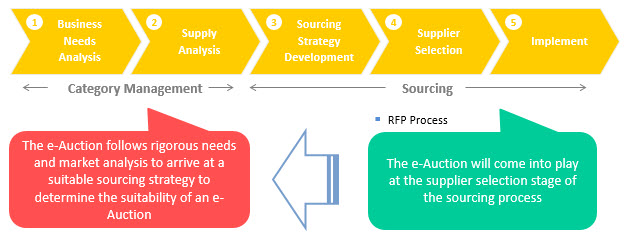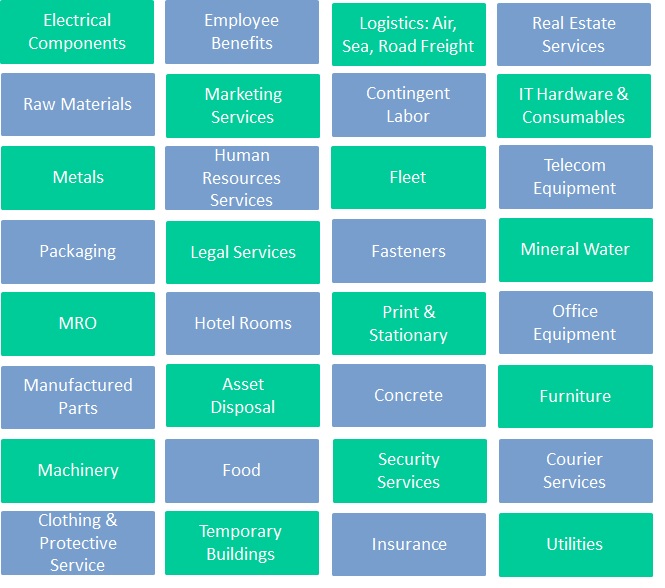e-Sourcing Facts: the Truth about e-Auctions Part 3
e-Sourcing Facts: the Truth about e-Auctions Part 3. The debate regarding whether e-Auctions are suitable only for commodities, or also for complex and highly-engineered items, continues.
Here in part 3 we counter the argument that e-Auctions are only suitable for non-complex categories and provide guidance for successful execution.
e-Auctions can work for almost any category
e-Auctions can be a suitable tactic for any category with a sound Category Strategy supporting its application. While suitable for both direct and indirect categories some might say:
‘if you can define it and if you have sufficient numbers bidding then it can be a success’.
In reality, however, it is more complex than this and requires a skilled Buyer. One who truly understands the business model and can create a competitive environment by identifying potential suppliers, taking into consideration their capabilities and capacities, and the market they operate in.
1. The Buyers role
The most important aspect of the buyers role is to create a competitive environment. The traditional skills of strategic sourcing including developing RFI’s & RFQ’s is an essential part of achieving a successful outcome.
For more complex categories, more time and resource is required to ensure a competitive environment and make an ‘apples to apples’ comparison.
Buyers must understand how a market works, the direction in which a market is heading, the competitiveness of the market, its suppliers and the value that suppliers place on their organization as a customer. Conducting an e-RFI at the Supply Analysis stage and an initial e-RFP or pre-market analysis is a best practice method required to gain a better understanding of how to structure your Event for complex categories.
1.1 Best practice dictates that time and resource must be spent:
- Making sure the specifications and expected service levels are correct and clearly defined.
- Ensuring stakeholder and supplier buy in.
- Ensuring that participants are bidding like-for-like.
1.2 Analyze each category rigorously to identify opportunities to use e-Auctions:
- Category Profiling: Is all about clearly defining a category and its sub-categories in terms of spend, scope, specification, etc. It is critical to defining a sourcing strategy for the e-Auction.
- Market Structure: How much ‘opportunity’ is there in a particular market?
- Resource Commitment: What time commitment are you willing to make to learning the business, to do an effective job of preparing the RFQ?
- Buyer Attractiveness: How attractive is the buyer and the market?
1.3 Attractiveness is heightened by market characteristics such as:
- Category Maturity: Are volumes growing, static or declining?
- Supplier base: the more attractive the buyer’s business, the more suppliers there will be competing for it. It is important, however, that Buyers invite only suppliers who have a real chance of winning the bid.
- Value of category requirement: the spend in the RFQ and the buyer’s reputation
- Market analysis:
- Seasonality: conducted an Event in off-peak periods is likely to receive significantly more competition than one conducted at peak times.
- General economic conditions:
- Following the 9/11 tragedy, it was relatively easy to generate a competitive environment with online auctions since the economy was experiencing a downswing and companies were eager to drum up business.
- Industry conditions: supply – demand ratio can be influencing factors. The ease of fulfilling the RFQ (in terms of capability and capacity)
It is the Buyers job to make the eAuction as attractive to potential suppliers as possible. A lot of market knowledge must be collected up-front, and the buyers preparation for the bidding event is critical to success.
If the Buyer is not doing an effective job of learning the business and preparing a level playing field, then an e-Auction is unlikely to be effective.
2. Successful Categories for e-Auctions
e-Auctions are conducted for categories ranging from raw materials, processed goods, business services, freight, and marketing services, etc. Nothing is exempt from reverse auction consideration.
2.1 Commodities
Commodities are often the low-hanging fruit for Buyers to become acquainted with e-Auctions, building the foundation to move to more complex products and services. The more commodity-like the product and service, the easier the e-Auction process. It is because:
- The number of willing and able suppliers to bid on the business is likely to be higher, due to lower item differentiation.
- In contrast, specialty items, perhaps featuring proprietary technology or components, may only be offered by a select few suppliers.
- The common threshold value for the minimum number of competitive bidders in an auction is three (although more are always desirable).
While still regarded as important, other aspects, such as quality and reliability, are considered secondary.
2.2 Highly-engineered or one-of-a-kind items
High item differentiation introduces additional complexity to an e-Auction Event. Frequently the buying organization will have preferences over non-price attributes of the sellers’ products, which need to be weighted to arrive at a value-focused outcome. Furthermore, several factors can diminish the importance of having a true commodity, such as the attractiveness of the auctioned item. If a high differentiated item is considered desirable by many suppliers, it can receive competitive bids.
2.3 Services:
Auctioning services is possible, but with greater difficulty. It is much more difficult to commoditize a service across different organizational facilities. Buyers must facilitate an agreed corporate service level which is very difficult to do.
In contrast to a component, for example, which is much easier to agree on a specification. Services, however, tend to carry much more emotion regarding both their specification and suppliers. The other challenge for buyers can be getting the data to adequately define the service.
Fig 1 below shows a non-exhaustive list of categories in which e-Auctions have been successful.
The caveat to running e-Auctions for high differentiated items and services is that you have to spend a lot more time on the preparatory work. It is the Buyers job to ensure clearly defined requirements, a detailed understanding of the supply market and ensure a competitive environment for the organization’s business. This is true for both traditional negotiations or an e-Auction. However, it is particularly critical to ensuring a successful e-Auction event.
3. e-Sourcing Facts: the Truth about e-Auctions
Conclusion
When administered and executed properly, all varieties of categories can be sourced through e-Auctions provided they have passed the Category strategy test.
If you find you can’t adequately define the product or service, then a different negotiation method should be sought instead of forcing an Event that does not yield the maximum benefit. The skill of the Buyer is critical.
Nuff said …
You can read part 2 here
Contact us to learn more about our e-Sourcing products


